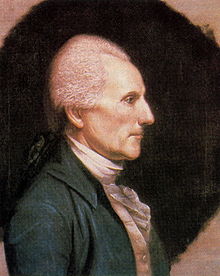
Back قرار لي Arabic Resolución de Lee Spanish Lee Resolution French Risoluzione di Lee Italian リー決議 Japanese Den amerikanske sjølvstenderesolusjonen NN 李氏決議文 Chinese


| Part of a series on the |
| American Revolution |
|---|
 |
|
|
The Lee Resolution, also known as "The Resolution for Independence", was the formal assertion passed by the Second Continental Congress on July 2, 1776, which resolved that the Thirteen Colonies, then referred to as the United Colonies, were "free and independent States" and separate from the British Empire, which created what became the United States. News of this act was published that evening in The Pennsylvania Evening Post and the next day in The Pennsylvania Gazette. The Declaration of Independence, which officially announced and explained the case for independence, was approved two days later, on July 4, 1776.
The resolution is named for Richard Henry Lee of Virginia, who proposed it to Congress after receiving instructions and wording from the Fifth Virginia Convention and its President Edmund Pendleton. Lee's full resolution had three parts which were considered by Congress on June 7, 1776. Along with the independence issue, it also proposed to establish a plan for ensuing American foreign relations, and to prepare a plan of a confederation for the states to consider. Congress decided to address each of these three parts separately.
Some sources indicate that Lee used the language from the Virginia Convention's instructions almost verbatim. Voting was delayed for several weeks on the first part of the resolution while state support and legislative instruction for independence were consolidated, but the press of events forced the other less-discussed parts to proceed immediately. On June 10, Congress decided to form a committee to draft a declaration of independence in case the resolution should pass; the following day, John Adams, Thomas Jefferson, Benjamin Franklin, Roger Sherman, and Robert R. Livingston were appointed as the Committee of Five to accomplish this. That same day, Congress decided to establish two other committees to develop the resolution's last two parts. The following day, another committee of five (John Dickinson, Benjamin Franklin, John Adams, Benjamin Harrison V, and Robert Morris) was established to prepare a plan of treaties to be proposed to foreign powers; a third committee was created, consisting of one member from each colony, to prepare a draft of a constitution for confederation of the states.
The committee appointed to prepare a plan of treaties made its first report on July 18, largely in the writing of John Adams. A limited printing of the document was authorized, and it was reviewed and amended by Congress over the next five weeks. On August 27, the amended plan of treaties was referred back to the committee to develop instructions concerning the amendments, and Richard Henry Lee and James Wilson were added to the committee. Two days later, the committee was empowered to prepare further instructions and report back to Congress. The formal version of the plan of treaties was adopted on September 17. On September 24, Congress approved negotiating instructions for commissioners to obtain a treaty with France, based on the template provided in the plan of treaties; the next day, Benjamin Franklin, Silas Deane, and Thomas Jefferson were elected commissioners to the court of France.[1] Alliance with France was considered vital if the war with Britain was to be won and the newly declared country was to survive.
The committee drafting a plan of confederation was chaired by John Dickinson; they presented their initial results to Congress on July 12, 1776. Long debates followed on such issues as sovereignty, the exact powers to be given the confederate government, whether to have a judiciary, and voting procedures.[2] The final draft of the Articles of Confederation was prepared during the summer of 1777 and approved by Congress for ratification by the individual states on November 15, 1777, after a year of debate.[3] It continued in use from that time onward, although it was not ratified by all states until almost four years later on March 1, 1781.
- ^ Milestones: 1776–1783: The Model Treaty, 1776, Department of State, Office of the Historian. Via the Internet Archive.
- ^ Jensen, Merrill (1959). The Articles of Confederation: An Interpretation of the Social-Constitutional History of the American Revolution, 1774–1781. University of Wisconsin Press. pp. 127–84. ISBN 978-0-299-00204-6.
- ^ Schwarz, Frederic D. (February–March 2006). "225 Years Ago". American Heritage. Archived from the original on 2009-06-01.
© MMXXIII Rich X Search. We shall prevail. All rights reserved. Rich X Search